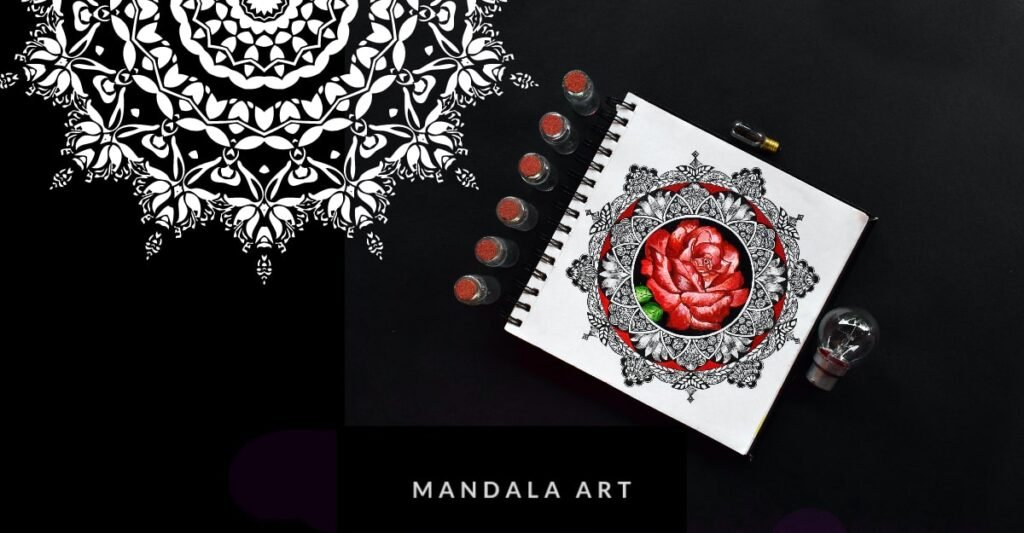Mandalas are a popular form of art that focuses and energizes the mind. People have been using mandalas for centuries to promote mental well-being and relaxation. Specialists often use it in therapies such as neurofeedback.
There are many different types of mandalas, and they can be created with any type of media (e.g., paper, paint, etc.). The basic shape of a mandala is typically a series of concentric circles or loops. You can add details to your mandala art therapy to make it more unique and expressive, or use it as an inspiration for creating your own design. expressive arts, and somatic therapy.
In this article, we will explore the different types of mandala art therapy and how you can use them to improve your mental health. One of the most common types of mandala art is “bumper” or “wheel” mandalas. These are often created by painting a series of concentric circles on a flat surface and then filling them in with various colors and designs. The circles can be any size, but they should generally be small enough so that you can easily focus on them while meditating or using neurofeedback therapy.
Another type of mandala is used in the arts.
What Is Mandala Art Therapy?
Mandala art therapy is a kind of psychotherapy where a trained therapist guides the clients suffering from a mental affliction. A variety of artistic processes are used where clients use geometric patterns to restore the sense of healthy mental-life balance.
The therapy is widely used in treating depression, PTSD, grief, anger management, low self-esteem, addiction management, stress relief, and anxiety symptoms improvement, and also helps with coping with any physical illness and disability.
Mandala art is also used with patients suffering from dementia, Down Syndrome, and Alzheimer’s. Drawing, coloring, or painting mandalas can be a great way to meditate, which can help the patients to relax and relieve stress.
There are three ways to heal: Mandala meditation, creating a mandala art kit and coloring a mandala.
- During the mandala creation process, a person is in the stage of mindfulness. They use this mindfulness to draw and help them focus their thoughts and energy on something that can help them get rid of anxiety and stress.
- Mandalas can even help to increase balance and optimism in life furthermore. It is proven that people who color mandalas experience a great sense of calmness and promote well-being of a person.
- Coloring mandalas have benefits for all age groups of people. There is no age restriction so anyone can start coloring mandalas. Mandala art therapy is a very smooth and nourishing process.
Additionally, mandalas help to gain a new perspective on life and help to get rid of stress and overthinking. This art form allows us to be more mindful and patient.
Mandala Art: An Amazing Therapy and Healing technique

Unique and the Sanskrit meaning of word mandala means a circle or a chakra. The word is pronounced as “mah-ndah-lah”. The word has been derived from two words “la” and “manda” which means container and essence.
Mandala Art Therapy has been considered a ritual symbol in Hinduism and Buddhism, which prominently represents the huge universe in particular.
Mandala is also known for its meaning, i.e., a circle or container of the essence. Many people believe that the mandala represents wholeness, health, connection, unity, harmony, and the whole cycle of life.
Many have even given it a wholesome meaning by calling it a symbol of being one with life, moving with the flow of life, and reflecting inward.
In fact, the different geometric patterns of the mandala art therapy represent the various aspects of the universe. They also use it as an instrument for meditating, ceremonial rituals and worship, and sacred art in many Asian countries.
A mandala will always consist of a dot, a central point known as the seed. This seed or the central point is the starting point of creating any mandala.
Types of Mandala Art Therapy
1. Teaching Mandala
Communities consider this type of mandala symbolic and believe that every shape, color, and line represents different aspects of Buddhism. In Buddhism, a monk learns the art of mandala while taking his monastic education.
They create mandalas based on the principles of design and construction which they learn. These mandalas often depict colorful mental maps describing the Himalayan culture beautifully.
2. Healing Mandala
People consider these types of mandalas more intuitive than teaching mandalas. The primary purpose of making these mandalas is to meditate.
The other motive for making them is to deliver wisdom, create an environment and feeling of ultimate calmness in oneself, and help focus and concentrate.
3. Outer Mandalas
People consider it the most basic type of mandala. These mandalas represent the universe. They make it for offerings. They consider offering these mandalas a standard practice in Buddhism for thanking people.
4. Sand Mandala
Both Buddhist monks and people of the Navajo culture have used sand mandalas as a traditional and religious element for a long time.
The sand mandalas are created using complex designs and the symbols are made using colored sand. These symbols represent the impermanence of human life.
Using Mandalas As An Art Therapy
The therapist asks the client to create mandalas that can represent their emotions. People find making mandalas comforting and a powerful tool for fighting against negative emotions, such as fear, anxiety, and anger. Interestingly, mandalas can give a very clear picture of the emotional state of their creator.
Therapists even suggest their clients maintain a mandala journal that helps the therapist know about a client’s emotional condition through the visual representations created. This technique works for everyone. In fact, through many observations, it was crystal clear that mandala symbols subconsciously absorb into an individual’s mind and help them with healing and self-reflection.
Mandalas Meditation
The client should make sure that he chooses a mandala that seems appealing to him. The next step after selecting a mandala should be to begin by focusing on the centre of the circle. This step is important as a person can only enter the mandala through this focal point and start the journey through symbolism.
Next involves a person focusing and taking on the beautiful patterns and colors of the mandala without distracting himself with other thoughts. Mandala is a long and involved process, so he should feel more relaxed when person gets deeper into the mandala. As the process continues further, he should experience the feeling of joy and peace or may hear and connect with the intuitive and divine messages.
Mandalas Creating
Creating a mandala itself feels very healing to the mind. In fact, using one’s intuition can be a great way to guide through the different mediums one would want to use for creating a mandala. To create their mandala, people can use anything like sand, watercolors, crayons, pastels, pencils, paint, leaves, gems, rocks, flowers, etc.
Moreover, it is important to set up the intention for the mandala so that healing is evoked in the right way. The next step should be to meditate for a few minutes on the same intentions. Then once a person a mentally prepared, he should begin creating his mandala from scratch. You can use mandalas for meditation purposes or hang them at a place to gaze at regularly. Both things can help as a stress buster, eventually helping the person heal.
Mandalas Coloring
Once a person completes the mandala, he can start with the coloring part. They can use anything according to their desire. Paints, watercolors, crayons, etc., anything you want to use for this purpose.
Additionally, Creating, coloring, and looking at the mandalas prepares the mind to take on the essence of oneness or completion. Creating and coloring mandalas helps declutter the mind by eliminating negative thoughts and focusing on the mandala patterns. Focusing on mandalas daily for a while can help distract oneself from everyday distractions.
Even the step of concentrating on the mandala patterns and design can aid the mind in calming. Although if the negative thoughts continue to distract, then one should try to focus on the mandala till their mind is calm and free from all the negative thoughts around them.
Don’t forget to check out our article:-
- Best 5 Easy Mandala Designs for Beginners
- Know The Secretes of Mandala Artwork
- Easy Mandala Art for Beginners | How to draw Mandala
- Meaning of Mandalas Art, History, Types, and Meaning of the Colors



